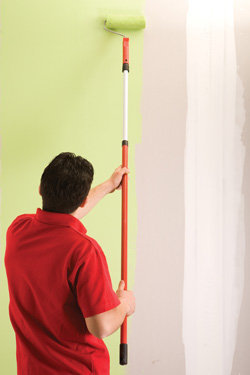REAL ESTATE

Remodeling? Here's what returns the most at sale
Remodeling projects makes life more pleasant and more beautiful. But you're not likely to get your investment back when you sell. Lower cost projects, like enhancing curb appeal, are more likely to pay for themselves. Other projects that provide a good return, according to The Wall Street Journal, are described by the National Association of Realtors.
A National Association of Realtors survey of more than 3,900 appraisers, sales agents and brokers provides these profitable modifications:
- Replacing siding with fiber-cement panels can return 79.3 percent of project cost.
- Replacing a garage door recoups 75.2 percent of costs,
on average.
- Master bedrooms, gourmet kitchens and fancy bathrooms generally recoup less than 60 percent of their costs.
- Installing insulated vinyl windows earns back 71.2 percent.
- A deck addition brings back 59.7 percent of costs.
- A new roof will return 56.7 percent of costs, while building a garage brings about 54.7 percent of costs at selling time.
- Expensive master suite additions pay off with only a 52.1 percent return.
Paying off your mortgage may not be best use for your money
Not having a mortgage can be satisfying but it may not be smart. Financial planners recommend you consider doing other things before you pay off your mortgage:
- Pay off credit card balances. Paying credit card debt gives you an instant return equal to the interest rate on your card.
- Financial planners say a mortgage is a good debt and should be one of the last ones to be paid off.
- Put extra money into your retirement account instead. The last 10 years of working and saving gives you a chance to stash more money in a tax advantaged retirement account. If you are over 50, you can put $23,000 in a 401(k) and $6,500 in an IRA or Roth IRA during 2013.
- Bulk up your emergency savings account. Unless you have six months of living expenses, you could end up draining retirement accounts. If you do that, you could be house rich and cash poor in retirement.
- Weigh the return versus the risk. At Kiplinger's Personal Finance, experts say if you're paying 4 percent interest on your mortgage and your nonretirement cash accounts are earning 1 percent, go ahead and pay off the mortgage.
- Have a flexible future. To pay off your home faster consider paying extra on the principle of your current mortgage. You could save a great deal of interest. And if your finances hit a rough patch you can revert to the lower payment.
- If you're paid ahead on some mortgages held by credit unions and banks you might not have to pay anything at all for a time.
Creepy haunts can brew up buyers
If you think Lizzie Borden taking an axe is scary, imagine you are the real estate agent trying to sell her house. Haunted houses can be a tough sell. Lizzie Borden is infamous for axing members of her family to death.

According to a poll by the Associated Press, 34 percent of people they interviewed believe in ghosts and 14 percent say they have actually seen one. About 26 percent of city folk say they are a little superstitious. Only 13 percent of rural people do.
Nonetheless, confronted with a nice home with an icky history, would you buy? That is a question asked by a visitor to apartment therapy.com. A couple about to buy a house discovered the previous occupant committed suicide. Would you buy or pass? Of the 234 responses, about 40 percent said no or offered advice on how to de-ghost the place.
To up the ante a bit, what if a great town home was on the California market in a fantastic neighborhood at a stunningly low price with a highly motivated seller. But there is a reason the price is so low. This is the town home of Nicole Brown Simpson, one of two people gruesomely murdered in the infamous trial of OJ Simpson. Would you buy?
This sort of property, called a stigmatized property, can be a tough sell, not only because of the history but because, at least early on, the location becomes a spooky tourist attraction.
According to MSN.com, Simpson's town home did sell. It took 2 1/2 years to sell. It sold for $200,000 off the asking price, according to AOL Real Estate. Experts say, in that neighborhood such properties sell within three months. The new owner remodeled the home's exterior.
But speaking of a bad address. Homeowners around another property actually changed the name of the street. In 1997, 39 members of the Heaven's Gate cult killed themselves to await an alien spacecraft. You won't find their notorious address any more and you won't find the $1.6 million home either. The landlord tried to sell, but could not. The lender finally sold it for less than $700,000 and it was bulldozed.
According to real estate consultant Bell Anderson & Saunders a buyer of a stigmatized home can expect from 10 to 25 percent off market prices.
However, some buyers can make a killing on homes with a creepy past. The legend of Lizzie Borden lives on in her home at 92 Second Street, Fall River, MA., now a bed and breakfast. And you'll feel very cozy when you read the motto: Where everyone is treated like family. Oh, wait . . .
Other than increasing our down payment is there anything else we can do about a low appraisal?
You can challenge the appraisal. That could work if you can show that the appraiser made what you feel are legitimate mistakes in the calculation: if the appraiser was unfamiliar with property values in the neighborhood, or if one or more foreclosed properties or short sales were included in the comps.
According to the National Association of Realtors, recently 9 percent of real estate agents reported a contract cancellation, 10 percent reported a delay and 13 percent experienced lower sales price negotiations due to a low appraisal.
To challenge an appraisal, you need to make your case with the commissioning lender. Though lenders are prohibited from communicating with the appraiser, they will commonly send the borrower's rebuttal to a third-party entity that hires appraisers for review.
A rebuttal needs to be limited to actual errors, flawed methodology by the appraiser, and/or additional new or missed comps which are recently sold homes that are comparable to the house that is for sale.
You have to write a formal rebuttal letter, also called a reconsideration letter, with input from a real estate agent or an appraiser. Be sure to show no emotion in your letter. Just tell the facts.
Many lenders now work with appraisal management companies which may have appraisers with limited experience. The lender gets a certain amount for an appraisal and may choose to select an appraising company that charges less.
Find out if the lender used an appraiser who comes from your county and who is a certified senior residential appraiser (SRA) or who is a member of the Appraisal Institute (MIA).
Meet the new appraiser when he or she inspects the home and share your knowledge of recent short sales and foreclosures that might skew the comps.
Mention any expensive updates that the first appraiser might have missed.

Many Americans are moving back to town
For decades, the American dream was a spacious house outside of the city with a big yard where the children and neighbor kids could play. It sounds perfect, but some suburbanites are having second thoughts, according to author Leigh Gallagher. In fact, according to census data, during the last four years cities have, for the first time, grown faster than the suburbs.
Gallagher's book, The End of the Suburbs: Where the American Dream is Moving, details the apparent trend of homeowners out of the burbs and into the city. That could be because cities save time.
In the suburbs the bread winner has a long commute to work. Meanwhile, one parent spends about three hours a day in the car driving the children to school, sports practice, their private lessons and places like the library. And finally, the big house and yard are a lot of work to maintain.
Because homes are far apart there are no casual, impromptu meetings with other kids or with other adults. Gallagher writes that suburbanites want a more walkable, urban community. It could be in one of the revitalized downtown areas of a city or in one of the "city replicas" in the suburbs. They range from smaller walkable residential villages to giant "lifestyle" centers.
Certainly, not everyone is disenchanted with suburban living. It still offers fresh air, elbow room, a high level of privacy, and a spacious structure where you can modify rooms to reflect what your interests are now. And you can invite boomerang kids or your mom and dad to stay with you.
Chicago builder John McLinden recalls the streets of his home town where residents sat on their porches, greeted and visited with people passing by. He's building such a place."


Insulating Flat Latex Ceramic Ceiling Paint
These paints can keep rooms quieter, warmer. They have Paint sound deadening properties.
Can you paint quiet on to your walls? Yes. And no. It really depends on what sounds you want to deaden. Acoustic deadening paints can help reduce the sounds of normal
conversations. That can be great for condos or apartments where shared walls can transmit way too much sound. Even in homes with thin walls, sound deadening paint can reduce average noises up to 30 percent.
But it's not for every sound problem. If you have a neighbor who plays the flute or a bass drum the paint won't help because these paints mainly address mid-frequency sounds. One example is Hy-Tech Acoustic Coat #150. It is a water based flat latex paint formulated with ceramic microspheres and sound absorbing fillers and resins. It costs $31.75 per gallon at hytechsales.com/prod150.html.
Paint with insulating properties
One example is Hy-Tech Ceiling Paint #110. This matte flat finish latex paint is designed as a insulator for ceilings and walls. On the ceiling, the paint traps heat that would normally move to the attic and roof. In the summer, heat from the attic does not move down to the rooms.It's formulated with a heavy concentration of insulating ceramics which can minimize minor surface imperfections. It's gelled to minimize splatter and dripping, has a low odor and dries in one to 3 hours. Apply with a brush, roller or spray. Soap and water cleanup. See hytechsales.com for more info.
Another feature: if you already have ceiling paint on hand you can add Hy-Tech insulating additive to it. Just pour your present paint into a large container and slowly mix the additive to it until it's well blended. It's for use on ceilings and walls, plaster, metal and wood.
© 2013 TLC Magazine Online, Inc. |